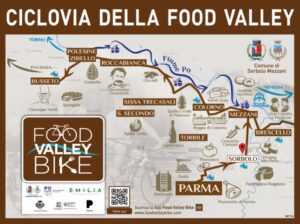Colorno celebrate the passage of Giuseppe Garibaldi
On the morning of 12th April, 1862 Giuseppe Garibaldi see foot in Colorno coming from Parma and headed to Casalmaggiore. He did not stay long, just for a quick stop to say hello to the town and then away to the land beyond the Po. The Municipality did not pay attention to expenses and built a triumphal arch at the entrance of the town, decorated the square, plentiful breakfast for nine people at the hotel Della Posta (six coachmen, one groom and two coaches), and a refreshment with sweets and “sciampagna”. To welcome the General there were the major Giovanni Maria Levacher, the council member Antonio Chevé and many other notables. The people welcomed him with great enthusiasm and a young woman, exited by his words of incitement to the fatherland, asked him if she could cut off a lock of his hair. She was certainly satisfied (it seems she was the daughter of the chemist Bocelli, who had fought with Garibaldi). It is not the only relic belonging to the General and present in the civic collection: there is the sabre donated to the General by the French government for the help given in the Prussian war with the Vosges Campaign (1870-71), received in Colorno through his doctor, Timoteo Riboli (1808-1897).
Colorno will later demonstrate its admiration for Garibaldi by dedicating to him the main square of the town and a plaque that is still seen in the same square, dated June 2, 1900, and in memory of the death occurred in Caprera on June 2, 1882.
The Garibaldians of Colorno
The contribution of the inhabitants of Colorno had been effective: 35 of them had volunteered and actively participated in the war campaigns to liberate the South. The names are in the list drawn up by the Municipality after the Unification of Italy.
We want to rememebr them all: «Guzzoni Melchiorre, Braciforte comandante Lodovico, Battioni Leopoldo, Canali Demetrio, Monici Eugenio, Giacomo Valenti, Sporta Giuseppe, Pellegrini Cipriano, Pecchioni Francesco, Gerbella Demetrio, Bocchia Pietro, Zanardi Ernesto, Zanardi Dalmazio, Zanardi Giacomo, Zanardi Giovanni, Morenghi Giuseppe, Fano Mosè, Zoni Parisi Marianna, Garzia Angelo, Geminiani Luigi, Gatti Gaspare, Marchiani Narciso, Papini Adolfo, Piccinini Nicola, Montecchi Annibale, Mazzera Pietro, Piccoli Enrico, Sichel Rutilio, Amoretti Antonio, Avanzini Giglielmo, Geminiani Antonio, Angelini Luigi, Bonazzi Luigi, Negri Luigi, Caldarini Fabiano».
It was a contribution in human strength and in money, for the decision to join the initiative “of the undefeated Our General Garibaldi for the purchase of a million rifles for the defense of Italy”. On November 3, 1859 “willing and unanimous”, the City Council had deliberated the contest of the Municipality “so striking patriotic proposal with the sum of five hundred lire”.
The history of Colorno in the portraits of Carlo Mattioli
In the hall of the City Council there are sixteen portraits of the famous painter Carlo Mattioli (born in Modena in 1911 and lived in Parma, where he died in 1944) of famous people who, as in the municipal archive, were commissioned in 1963 by Augusta Ghidiglia Quintavalle, superintendent of the National Gallery of Parma, characters “who had both by birth and political ties or culture related to the history of Colorno”, sovereigns, men of arms and church, artists and writers.
The investment by the Municipality was due to comply the Law 717 – 1949, called law “percent for art”, which, inspired by the Art. 9 of the Constitution (promotion of culture), obligates the public institutions at the time of the construction of a new building, to allocate to their landscaping a share not less than 2% of the value of the property, even with the purchase of works of art of painting or sculpture.
In 1964, the historic Longara was finally demolished and the construction of the New Town Hall was started; today it is possible to admire there the half- busts of Maria Luigia, Azzo da Correggio, Zaccaria Olivieri or the Bishop Martino da Colorno



